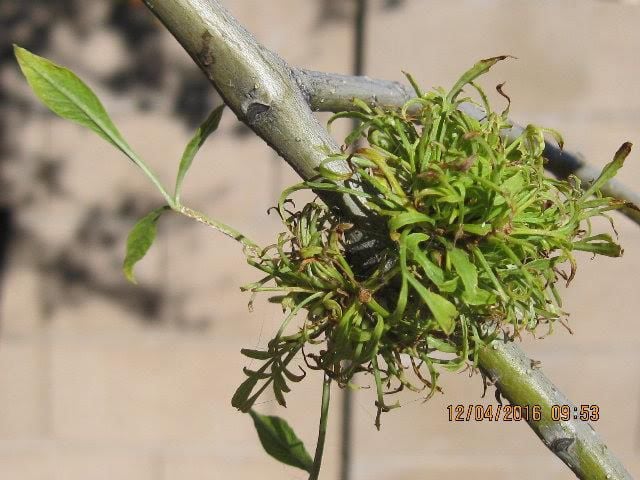Q: My bermuda grass is becoming dormant. I read an article some time ago that suggests that during winter months one should water the grass about once every 14 days. This will supposedly keep the roots alive. Do you agree with this or do you have another suggestion?
A: Yes, I agree. Even though bermuda grass is dormant during the winter it still requires irrigation (½ inch every two to three weeks) to keep the soil moist and prevent winter desiccation. Of course winter rains may cover this so it would be wise to monitor the situation so as not to overwater.
I am looking for the amount of water used by trees. I am assisting a committee in our 50-year-plus homeowners association to determine how much water the established trees are using. If there is a web page or some other compilation I would be grateful. These trees are the main ones: mesquite, oaks, palo verde, ironwood; these multi-branched shrubs are fillers such as Texas ranger varieties, native feather dusters, oleander, and jojoba.
How much the plants are using is hard to determine. While some research has been done in this area on crop plants, we don’t have as much information for landscape plants. We have some broad guidelines for watering trees and shrubs based on plant type, their status as native or non-native, and whether they are well adapted to the desert. Google “Landscape Watering by the Numbers” to see a helpful publication on this topic. The actual needs will be dependent on our overall climate, microclimates where they are planted, and the size of the plants. By following general guidelines for the plant, using a soil probe to ensure water is reaching the correct depth, and looking for signs of desiccation or overwatering, you should be able to get a sense of how much water is required.
Q: Several of these growths appeared on a shrub in my yard. Any thoughts on what it might be?
A: These are praying mantis egg cases, aka ootheca. After mating, female mantids lay their eggs in a foamy mass on trees and shrubs where their young will be close to something to eat when they emerge. The egg case, while soft at first, hardens into what you found and can contain up to 400 eggs. Mantids survive the winter as eggs in the ootheca and hatch in the spring, emerging as wingless nymphs. Mantids are predators and they require food soon after emerging. Finding none, they may begin to eat each other. So if you decide to keep your mantid eggs to watch them hatch you might want to also find a suitable food source for when they are ready. What happens this time of year is the accidental mantid colony on Christmas trees. The egg cases are often well hidden in the foliage and not always apparent when we are out selecting the family Christmas tree. If they should hatch in your house, they might be goners unless you can get them to a place outdoors where the weather outside isn’t frightful and that has a population of tiny insects.
I have three Arizona ash trees that are 10 years old. This past year they have looked like this (see photo). I have been trying to figure this out. I went to a few nurseries and got different answers and remedies: not enough water and not enough fertilizer. I water them once a week for one hour until I get over an inch of water in my rain gauge. I use shrub and tree fertilizer but I still have the problem. What is your opinion on this?
Your ash trees are displaying what is commonly called a witch’s broom. The normal growth of the tree has been interrupted, producing tiny leaves together in bunches from the same location we expect leaves. The causes of this are not always clear. Some possible problems could be a fungal infection, herbicide exposure or other environmental condition, mites feeding on the trees, and microorganisms called phytoplasmas that may be vectored by insects such as leafhoppers. In some cases, the trees will grow out of this and in others you might need to manage the situation. If you want me to examine a cutting for mites, etc., then please let me know.





